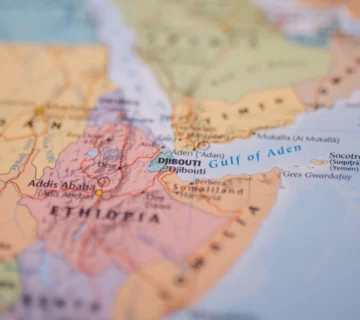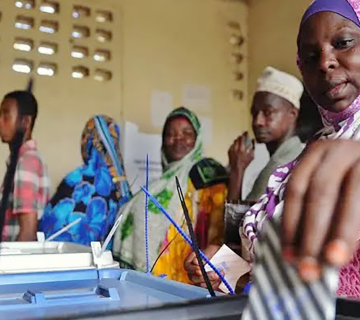In late January 2021, armed men ambushed Kenyan security officers near the town of Kapedo in Turkana East Sub-County, injuring three. During the fighting, the attackers ambushed and destroyed an armored personnel carrier and damaged a helicopter. Although the element of surprise certainly contributed to their success, the attackers’ ability to target military vehicles and aircraft is consistent with reports of their having sophisticated weaponry. On separate occasions, armed men also killed the head of the Rapid Deployment Unit in Kapedo and a deputy director of operations of the General Service Unit, both of which are paramilitary police organizations. The area is a focal point of conflict between the pastoralist Turkana and Pokot communities. Over 50 people have died in the area since 2014 (including 24 police officers) and 9,000 have been displaced.
To reduce violence in Kapedo, Kenya should prioritize efforts aimed at reducing community grievances before moving to enforce compliance with community disarmament initiatives. These could include the establishment of a civil education program aimed at promoting peaceful conflict resolution, close collaboration with religious and aid organizations to reduce immediate food scarcity and soothe tensions, and investment in the expansion of existing irrigation infrastructure. The Kenyan Police Service (KPS) should also take steps to increase its permanent presence in the area and abandon the current retaliatory ‘surge’ approach that has thus far proved ineffective in providing long-term stability.
Kapedo’s Conflict Drivers
A 2018 study identifies a set of core issues that contribute to the continued instability in Kapedo. Competition over access to pasture and water drives much of the conflict in the area. Cattle rustling, and the accompanying attacks on herders and communities, fuels the continuing violence. The economic impact and the killings associated with cattle rustling and intercommunal violence creates a destructive cycle in which communities seek to recoup their losses and make up for past injury.
There is also a weak security presence in the area. The few police officers present must navigate a hostile environment (including difficult terrain) and are reportedly often outgunned by the locals. Another key contributing factor to the continued insecurity is local leaders inciting violence to promote their own agendas. These politicians do not denounce violent acts when they occur, further aggravating tensions and undermining efforts to promote accountability.
Underpinning many of these issues is a lack of clarity surrounding the area’s administrative boundaries. The disputed boundary is especially important to local politicians who seek to profit from the area’s oil and geothermal power prospects (the government is working to build geothermal power infrastructure near Kapedo).
Role of Illicit Weapons
The North Rift Valley (where Kapedo is located) has the highest percentage of gun ownership in the country (11.3 per cent). The Rift Valley Regional Commissioner asserts that the proliferation of firearms in Kapedo is a primary factor behind the recent upsurge in lethal clashes. This belief is partially consistent with the existing literature on small arms and light weapons (SALW) proliferation. Although SALW do not cause conflict, they do increase the level of violence and complicate conflict resolution efforts. The insecurity that follows SALW proliferation exacerbates subverts economic activity, damages infrastructure, and prevents access to basic services.
SALW proliferation in Kenya is certainly not unique to Kapedo. According to the Geneva-based Small Arms Survey Project, only 8,136 of Kenya’s estimated 650,000 privately-owned firearms in 2012 were licensed. Illicit firearms are reportedly sourced from insurgent groups in Ethiopia, Somalia, and South Sudan. Kenyan authorities say the majority of illicit firearms are acquired and brought into Kenya by “small-time traders” that take advantage of Kenya’s relatively porous borders.
Current Government Response
According to Kenya’s Firearms Act, those who are found in possession of a firearm without a license face five to 15 years in prison. However, Kenya remains home to hundreds of thousands of unlicensed weapons. Armed youth around Kapedo openly carry assault rifles to protect themselves from rival communities. Firearms are widely accepted by communities around Kapedo and are seen as essential to their physical security as well as for protecting their livestock.
In response to the killings of its officers, the KPS launched an operation that resulted in the arrests of seven people and the recovery of 35 firearms. However, the security officers stand accused of human rights violations during the conduct of the operation, including the alleged extra-judicial killing of six people. Accompanying the increased police presence was a week-long amnesty for residents to turn in their firearms. However, this effort was met with limited success. Locals often own multiple firearms and provide defective ones to the authorities to feign cooperation.
Way Forward
Ideally, Kenya should work to enhance its current border security measures and to develop closer and more collaborative relationships with border communities. This would help reduce the illicit weapons flows that exacerbate internal security challenges in the North Rift Valley and northeastern Kenya. However, given the scale and the immense resources required to accomplish this, a more locally-oriented approach is best suited for reducing violent conflict in Kapedo.
Government efforts to stabilize Kapedo would be more effective if they gave first priority to development efforts that reduce community grievances before turning to enforce compliance with community disarmament initiatives. The government (at both the national and county level) should work with aid and religious organizations to help reduce immediate food scarcity and soothe tensions. In the longer term, the government should explore opportunities to create additional irrigation infrastructure that increases available pasture, thus reducing competition for water and grazing land. Expanding existing irrigation infrastructure would also enable some residents to adopt the cultivation of drought-tolerant crops such as sorghum and millet as a reliable alternate source of food and income to supplement their pastoral activities. A civil education program that incorporates members of the Turkana and Pokot communities as well as the local police should be established to discuss peaceful and legal methods of dispute resolution.
These recommendations cannot be accomplished without the establishment of a somewhat secure environment. The KPS must seriously reevaluate the way it views Kapedo. The current status quo of usual police neglect (evidenced by a chronically weak security presence) interrupted by the occasional heavy-handed surge is not conducive to stability. The KPS should increase its long-term presence in the area and provide incentives for promising officers to serve there (such as hazard pay and increased promotion potential).
Lastly, officials must make absolutely sure that any efforts to disarm the communities clashing in the Kapedo region do not favor one community over the other. Failure to do so risks a significant and one-sided increase in fatalities.
Joseph Hartung is a Researcher at the HORN Institute.
Photo: Herdsmen in Kapedo. Armed youth around Kapedo openly carry assault rifles to protect themselves from rival communities. (Photo: Nation Africa)



